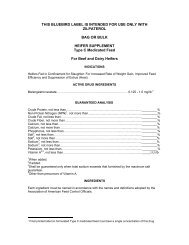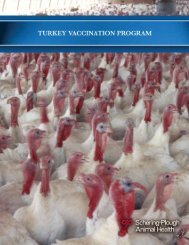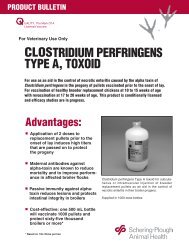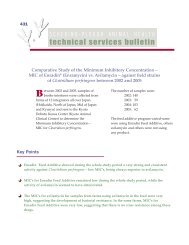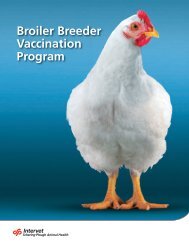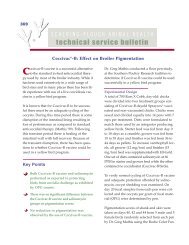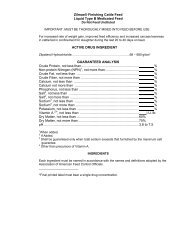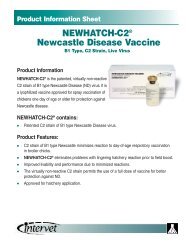2 BIG REASONS You Should Switch to Amoxi-Mast® Mastitis Tubes
2 BIG REASONS You Should Switch to Amoxi-Mast® Mastitis Tubes
2 BIG REASONS You Should Switch to Amoxi-Mast® Mastitis Tubes
- No tags were found...
You also want an ePaper? Increase the reach of your titles
YUMPU automatically turns print PDFs into web optimized ePapers that Google loves.
Distributed by:Schering-Plough Animal Health Corp.Union, NJ 07083, USAPrinted in USA(amoxicillin)LACTATING COW FORMULA(FÓRMULA PARA VACAS LACTANTES)Intramammary Infusion(Infusión intramamaria)CAUTION: Federal law restricts this drug <strong>to</strong> use by or on the order of alicensed veterinarian.<strong>Amoxi</strong>-Mast (amoxicillin) is specially prepared for the treatment ofbovine mastitis in lactating cows.DESCRIPTION: <strong>Amoxi</strong>-Mast is a stable, nonirritating suspension ofamoxicillin trihydrate containing the equivalent of 62.5 mg of amoxicillinper disposable syringe. <strong>Amoxi</strong>-Mast is manufactured by a nonsterilizingprocess.<strong>Amoxi</strong>cillin trihydrate is a semisynthetic penicillin derived from thepenicillin nucleus, 6-amino-penicillanic acid. Chemically, it isD(-)-α-amino-p-hydroxybenzyl penicillin trihydrate.ACTION: <strong>Amoxi</strong>cillin is bactericidal in action against susceptible organisms.It is a broad-spectrum antibiotic which is effective against commoninfectious mastitis pathogens, namely Strep<strong>to</strong>coccus agalactiaeand penicillin-sensitive Staphylococcus aureus.In vitro studies have demonstrated the susceptibility of the followingstrains of bacteria: α- and β-haemolytic strep<strong>to</strong>cocci, nonpenicillinaseproducingstaphylococci, and Escherichia coli. Susceptibility has notbeen demonstrated against penicillinase-producing bacteria, particularlyresistant staphylococci. Most strains of Pseudomonas, Klebsiella,and Enterobacter are resistant. The clinical or subclinical significanceof these in vitro studies is not known.INDICATIONS: <strong>Amoxi</strong>-Mast is indicated in the treatment of subclinicalinfectious bovine mastitis in lactating cows due <strong>to</strong> Strep<strong>to</strong>coccusagalactiae and penicillin-sensitive Staphylo coccus aureus. Earlydetection and treatment of mastitis is advised.WARNINGS: Milk taken from animals during treatment andfor 60 hours (5 milkings) after the last treatment must not beused for food. Treated animals must not be slaughtered forfood purposes within 12 days after the last treatment.PRECAUTION: Because it is a derivative of 6-amino-penicillanic acid,<strong>Amoxi</strong>-Mast has the potential for producing allergic reactions. Suchreactions are rare; however, should they occur, the subject should betreated with the usual agents (antihistamines, pressor amines).DOSAGE AND ADMINISTRATION: Milk out udder completely. Washudder and teats thoroughly with warm water containing a suitabledairy antiseptic. Dry thoroughly. Clean and disinfect the teat withalcohol swabs provided in the car<strong>to</strong>n. Remove the syringe tip coverand insert the tip of the syringe in<strong>to</strong> the teat orifice. Express the suspensionin<strong>to</strong> the quarter with gentle and continuous pressure. Withdrawthe syringe and grasp the end of the teat firmly. Massage the medicationup in<strong>to</strong> the milk cistern.For optimum response, the drug should be administered by intramammaryinfusion in each infected quarter as described above. Treatmentshould be repeated at 12-hour intervals for a <strong>to</strong>tal of 3 doses. At thenext routine milking after the last dose, the treated quarter should bemilked out and the milk discarded.Each car<strong>to</strong>n contains 12 alcohol swabs <strong>to</strong> facilitate proper cleaningand disinfecting of the teat orifice.HOW SUPPLIED: <strong>Amoxi</strong>-Mast is supplied in car<strong>to</strong>ns of 12 single-dosesyringes with 12 alcohol swabs. Each 10-mL, disposable syringe containsamoxicillin trihydrate equivalent <strong>to</strong> 62.5 mg of amoxicillin activity.Do Not S<strong>to</strong>re Above 24°C (75°F)NADA #55-100, Approved by FDAManufactured by:G.C. Hanford Mfg. Co.Syracuse, NY 13201Copyright © 2003, Schering-Plough Animal Health Corp., Union, NJ 07083.All rights reserved.10/03 27864503DISCLAIMER: Every effort has been made <strong>to</strong> ensure the accuracy of theinformation published. However, it remains the responsibility of the readers<strong>to</strong> familiarize themselves with the product information contained onthe product label or package insert.Copyright © 2007, Schering-Plough Animal Health Corporation. All rights reserved.<strong>Amoxi</strong>-Mast is a registered trademark of Schering-Plough Animal Health Corporation.ToDay, Cefa-Lak and Hetacin-K are registered trademarks of Wyeth. SpectraMast is aregistered trademark of Pfizer, Inc. SPAH-MAS-27
<strong>BIG</strong> REASON NUMBER 1The Simple Economics of <strong>Amoxi</strong>-Mast ® Compared <strong>to</strong>Other <strong>Mastitis</strong> Tube TreatmentsAntibioticmilkout periods of select mastitis tube treatmentsNumber ofTreatmentsMilkHold(Hrs)<strong>Amoxi</strong>-Mast ® 3 60 Tube Tube TubeToDay ® 2 96 Tube TubeCefa-Lak ® 2 96 Tube TubeDay 1 Day 2 Day 3 Day 4 Day 5 Day 6 Day 7 Day 8AM PM AM PM AM PM AM PM AM PM AM PM AM PM AM PMMilkreturn<strong>to</strong> tankSpectramast ® LC 5 72 Tube Tube Tube Tube TubeHetacin-K ® 3 72 Tube Tube TubeMilkreturn<strong>to</strong> tankMilkreturn<strong>to</strong> tankMilkreturn<strong>to</strong> tankMilkreturn<strong>to</strong> tank• AMOXI-MAST has the shortest milkout of the treatments compared.AntibioticTotal treatment cost (estimated in july 2007)*Number ofTreatmentsEstimatedTreatment Cost ($) Cost of Milk Withhold ($)A = number of tubes B = number of milkings on withholdx unit pricex milk price x milk production per milkingTotalTreatment Cost ($)<strong>Amoxi</strong>-Mast ® 3 $5.93 $43.50 $49.43ToDay ® 2 $3.83 $54.38 $58.21Cefa-Lak ® 2 $3.83 $54.38 $58.21Spectramast ® LC 5 $16.13 $81.56 $97.69Hetacin-K ® 3 $5.14 $59.81 $64.95A + B*Based on the best price for each product on a survey in July 2007. Cost of milk withhold considers two milkings per day, 37.5 pounds of milk per milking and milk price of $14.50 cwt.• AMOXI-MAST is the most economical of the treatments compared.
Calculate your own comparison <strong>to</strong> see the value of AMOXI-MAST on your farm.AntibioticTotal treatment cost – make your own calculationNumber ofTreatments<strong>Amoxi</strong>-Mast ® 3EstimatedTreatment CostA = number of tubesx unit priceCost of Milk WithholdB = number of milkings on withholdx milk price x milk production per milkingTotalTreatment Cost ($)A + BToDay ® 2Cefa-Lak ® 2Spectramast ® LC 5Hetacin-K ® 3<strong>BIG</strong> REASON NUMBER 2The Highest Bacteriological Cure Rates with AMOXI-MASTin an Independent Scientific StudyTreatment<strong>Amoxi</strong>-Mast ®(amoxicillin)ToDay ®(cephapirin)Cefa-Lak ®(cephapirin)Hetacin-K ®(hetacillin)Cure rates for 21 mastitis agents treated withintramammary infusion or receiving no treatment*Proportion of Cases Cured(Ratio) Cure Rate RR 1 CI 2908 / 1103 82% 1.3 b 1.2, 1.3152 / 222 68% 1.1 acd 0.9, 1.2152 / 222 68% 1.1 acd 0.9, 1.235 / 56 62% 1.0 abd 0.7, 1.3Untreated 4206 / 6481 65% 1.0 a1RR = Relative Risks. Relative risks with different superscripts differ significantly from one another (i.e., their confidence intervals do not overlap). Relative risks are <strong>to</strong> be compared with the untreated group.2CI = Confidence Interval. If the CI includes 1.0, the relative risk for the treatment does not significantly differ from the relative risk for the untreated group. Confidence interval of 99.3% = 100% minus (0.05/7) with seven comparisons made*Adapted from Wilson, DJ et al (1999). Comparison of seven antibiotic treatments with no treatment for bacteriological efficacy againstbovine mastitis pathogens. J Dairy Sci. 82:1664-1670.“Milk culture results were retrospectively reviewed from 9,007 cases of subclinical mastitis affecting cows housed in dairy herds locatedin New York and northern Pennsylvania. Cases included in this study had at least one mastitis pathogen isolated from the initial milksample, were recultured within one month, had permanent cow identification, and had records for whether mastitis was treated withan antibiotic or no treatments at all.”High cure rates with AMOXI-MAST combined with economy means cost-effective treatment!



